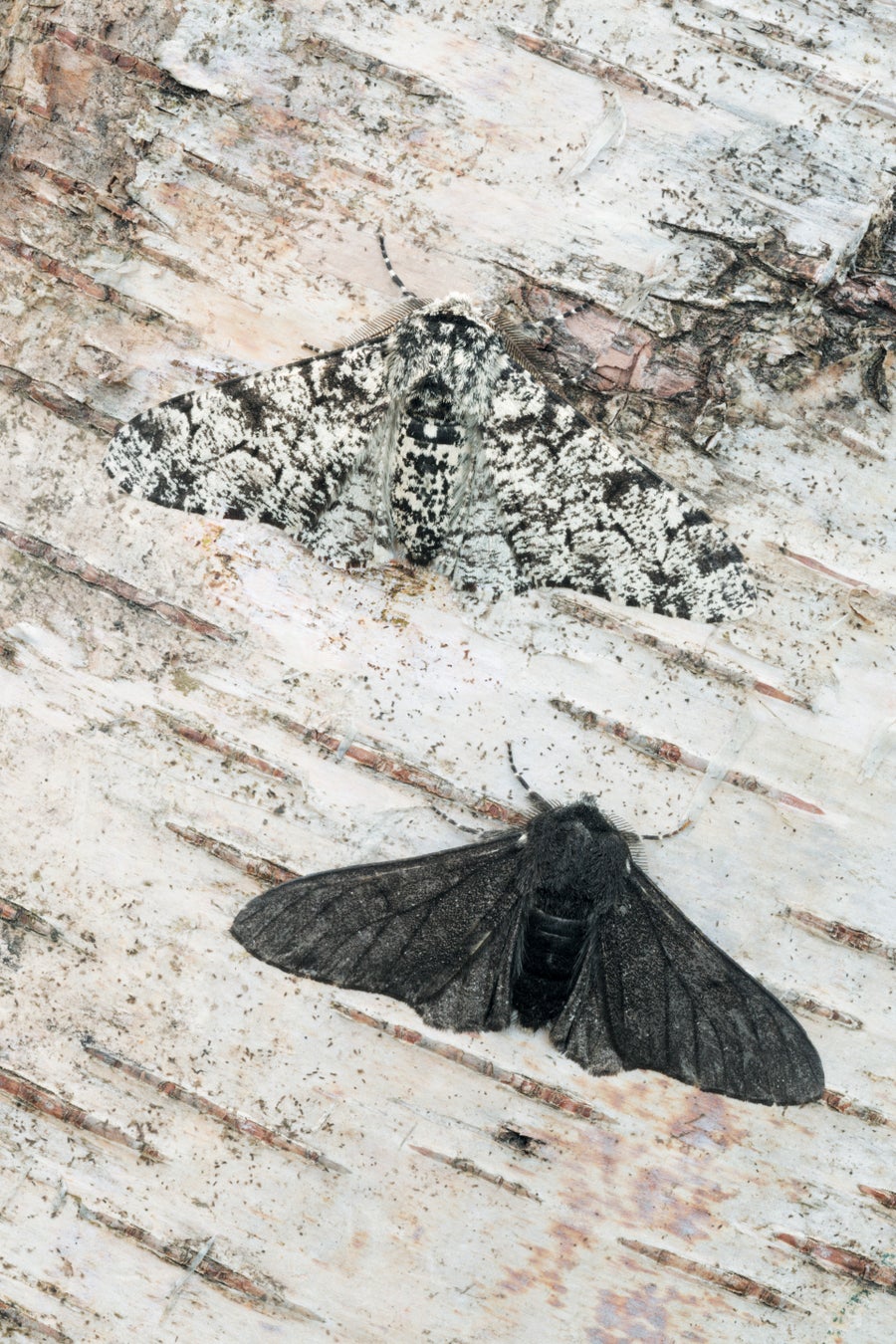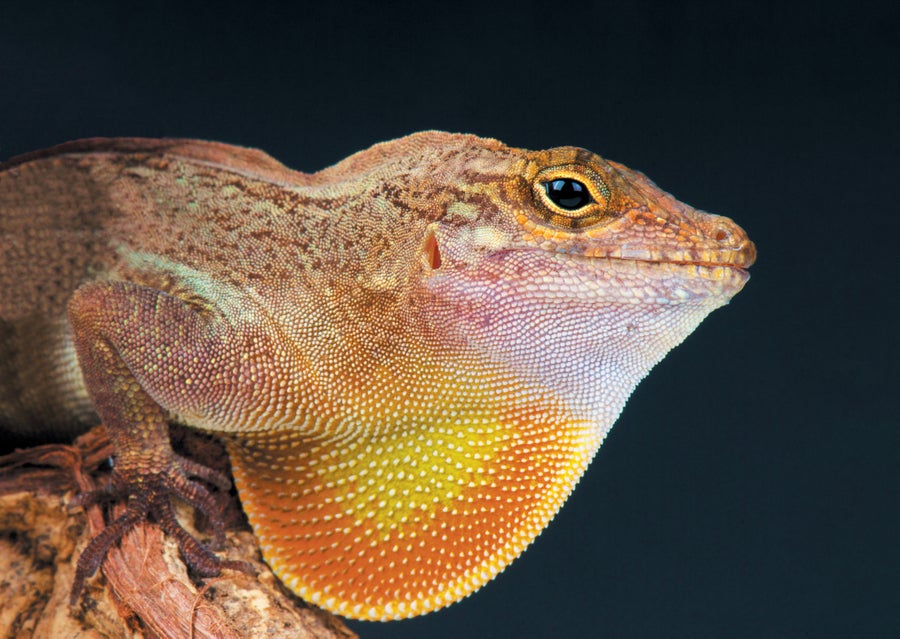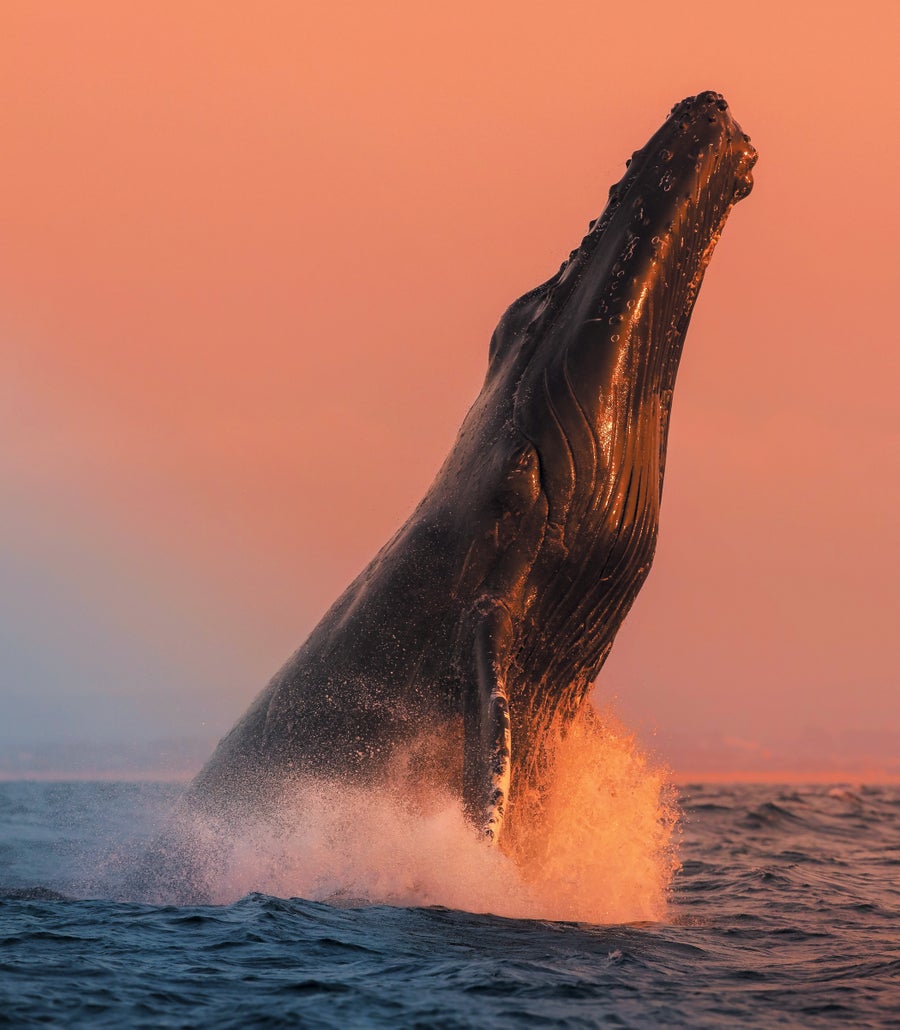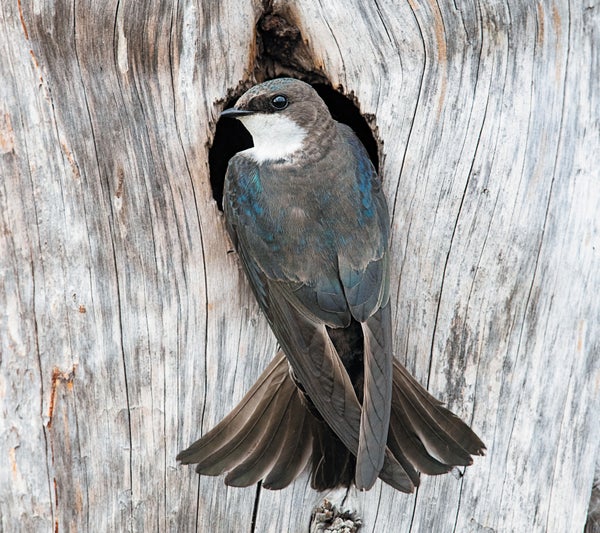The peppered moth is an iconic example of Charles Darwin’s theory of evolution by natural selection. For centuries peppered moths (Biston betularia) were common in the forests around Manchester, England, and elsewhere. With their light-colored wings, peppered moths were camouflaged from predators against the light-gray bark of the trees they rested on during the day. By the early 19th century, however, soot from the industrial revolution had forged a new evolutionary environment, one that favored dark-colored moths, which matched the soot-covered trees better than their lighter peers. In the 1950s and 1960s evolutionary biologists found that in industrial areas, 80 percent of the moths were dark-colored, and the dark moths had a 2:1 survival advantage over light-colored moths in those areas. Today, in our age of molecular genetics, we know the mutation that probably produced the dark-colored moths occurred around 1819 and was the result of “jumping genes”—bits of DNA that change position in a genome and may create a mutation in the process.
The darkening of the peppered moth is also an example of anthropogenic evolution: evolutionary change caused by alterations humans make to the environment. In recent years scientists have identified many more cases of human-mediated evolutionary change. The full scope and effects of anthropogenic evolution are only now coming into focus. But already we have ascertained that humans are shaping the evolutionary trajectories of animals across the globe, from insects to whales. As a result of our influence, key aspects of animal behavior are changing, including where they live, where they breed, what they eat, whom they fight and whom they help. We are remodeling more than just the environments species live in. We’re altering the species themselves as they evolve in response to our impact on their surroundings.
One consequence of this change is that we are creating mismatches between animals and the settings in which they evolved. Creatures once well equipped to meet the challenges of their environment suddenly face a world in which their fine-tuned behavioral adaptations are no longer adaptive at all. In some species, natural selection is recalibrating behavior so that individuals are better suited to their new circumstances. The question is whether it will be able to do so fast enough to keep pace with human transformation of the planet we all share.
On supporting science journalism
If you're enjoying this article, consider supporting our award-winning journalism by subscribing. By purchasing a subscription you are helping to ensure the future of impactful stories about the discoveries and ideas shaping our world today.
For long stretches of evolutionary time, natural selection has favored a tight link between ambient temperature and the start of the breeding season for many animals, including birds. Hormones associated with reproduction kick into gear when the weather warms; birds court, construct nests and bring food home to deposit into the mouths of their waiting young. For Tree Swallows (Tachycineta bicolor), the spring thaw is the trigger that sets that reproductive cascade into motion. But that trigger is now being pulled too early. Largely as a result of increased carbon dioxide emission, the average spring temperature for Tree Swallows living in northern New York increased about 1.9 degrees Celsius between 1972 and 2015, and the spring thaw is starting earlier. Over that same period Tree Swallows started breeding 13 days earlier. The environmental cue the birds use to time breeding has become mismatched with their altered conditions.

Peppered moth.
Alex Hyde/Getty Images
Because of this mismatch, breeding swallows risk experiencing cold snaps they otherwise would not have been exposed to. These cold snaps don’t directly affect the survival of adult birds, but they do reduce the activity of the insect prey that swallows bring back to their hungry nestlings. Parents are unable to find enough food for their brood, which leaves their young less likely to survive and reproduce.
Using data on 11,236 chicks from more than 2,000 nests, J. Ryan Shipley, now at the Swiss Federal Institute for Forest, Snow and Landscape Research, and his colleagues found that Tree Swallow nestlings that hatched between 2011 and 2015 were twice as likely to have experienced a cold snap during their early development as birds that had hatched in the 1970s. One upshot of that was an increase in the number of complete nest failures in which every single nestling in a nest died. A nasty cold snap in June 2016 led to the death of 71 percent of chicks in nests that year. Mass casualties were not the only detrimental effect Shipley and his team observed. They also found that nests in which eggs hatched before the last cold snap had, on average, one fewer surviving chick than nests in which eggs hatched after the last cold snap.
Of course, not every Tree Swallow responds to the onset of spring thaw in exactly the same way. Some may initiate breeding earlier than the average bird, others later. If that variation is based on underlying genetic differences, then it is reasonable to expect natural selection to favor birds that start breeding later. But this mismatch is a daunting problem for natural selection to solve. Unlike feather coloration getting a bit brighter or drabber, recalibrating the links between temperature and the onset of mating is incredibly complex, involving hormonal, neurobiological and behavioral changes. It may take more time than the swallows have.
Air pollution is not the only anthropogenic disturbance producing a discrepancy between environmental cues and the onset of reproduction. Artificial light at night (ALAN), caused by everything from streetlamps to car headlights to residential and commercial housing, is having similar effects. The problem isn’t just that birds migrating at night crash into lit buildings, although that is part of it.
To examine the impact of light pollution on the courtship displays of the firefly Photuris versicolor, a species in which both males and females flash light signals, Ariel Firebaugh and Kyle Haynes of the University of Virginia set up experimental plots, each of which contained a mesh canister. From 9:30 P.M. to 11:30 P.M. on 10 consecutive nights, they placed a female in each canister and recorded her flash rate, along with the number of males who approached her canister and how often they flashed. Some experimental plots were lit by two white floodlights, whereas others had no artificial light. Unlit plots drew in relatively few fireflies, but of the fireflies recorded in them, around 90 percent of stationary females and 65 percent of visiting males flashed courtship displays. Lit plots had significantly more firefly visitors, but not a single male or female in these plots flashed—not even once. Under ALAN, fireflies abandoned their normal courtship ritual. Just as with CO2 emission and Tree Swallow breeding season, ALAN is placing animals in environments that are dramatically different from those in which their ancestors evolved. Whether P. versicolor can adapt to these changing environments over time remains to be seen.
Evolutionary mismatches are just one consequence of anthropogenic change; the creation of ecological traps is another. These traps occur when, after some relatively rapid change to the environment, animals display a preference for suboptimal habitats that reduce their reproductive success. Ecological traps need not be physical traps, but they can be. One such trap results from used tires. People toss roughly 30 million metric tons of tires every year, and although some are repurposed, many are dumped into the environment, often illegally.
Atsushi Sogabe and Kiichi Takatsuji of Hirosaki University in Japan studied the ecological traps that discarded tires create for hermit crabs. Their work began after they observed many small snail shells inside a tire on the floor of Japan’s Mutsu Bay. In most hermit crab species, the head and thorax are protected by a calcified exoskeleton, but the abdomen is not. The crabs use discarded shells from mollusks, including snails, to shield their vulnerable abdomen. Hermit crabs are always looking to upgrade to a better shell. Sogabe and Takatsuji saw many a crab scrounging among the shells that had accumulated in the discarded tire. The researchers hypothesized that once inside, crabs wouldn’t be able to climb the concave inner wall to leave and therefore would eventually die in the tire. When the scientists brought a discarded tire into their laboratory and placed hermit crabs inside it, not a single crab could get out.
Sogabe and Takatsuji then ran a field experiment in which they placed six tires on the seabed in Mutsu Bay. A year and a half later, after the tires had been in place long enough to acquire lots of shells—the remains of snails that were most likely drawn to the tires to feed on the algae that accumulates on them—the researchers began monthly collections of hermit crabs from the tires. Over the course of 12 months they collected 1,278 hermit crabs that had gotten stuck in those six tires. It’s unclear whether the crabs will evolve physical or behavioral adaptations that can help them escape this ecological trap.
Urbanization is a driving force in anthropogenic evolution. One way to measure its extent is by using the so-called Human Footprint Index, a composite measure that takes into account human population density, land use, ALAN, roads, railroads, navigable rivers, and more. Marlee Tucker of Radboud University in the Netherlands and her colleagues analyzed GPS data from 803 individual animals belonging to 57 mammal species across the globe, including Mongolian wild ass (Equus hemionus hemionus), giraffe (Giraffa camelopardalis), brown bear (Ursus arctos), roe deer (Capreolus capreolus), European hare (Lepus europaeus) and brushtail possum (Trichosurus vulpecula). They found that in areas with a large human footprint, such as urban areas, animals moved around in their environment only half as much as animals in low-footprint areas.
Animals in and around the towns and cities we have built live radically different lives from those in nearby rural environments. They encounter different foods, predators, light and surfaces. Soundscapes are also extremely different in cities, where animal communication is often masked, garbled, and otherwise hindered by the hubbub we humans produce.
Black asphalt pavement and the metal in buildings are excellent heat conductors, and together they give rise to what are known as urban heat islands. One study of 57 cities across Scandinavia found that temperatures in urban areas were up to five degrees C higher than those in adjacent rural locales. Evolutionary biologists such as Shane Campbell-Staton of Princeton University are beginning to piece together how urban heat islands impose new selective forces on species that live in these settings. He and his colleagues have studied the effects of urban heat islands and anthropogenic evolution in crested anole lizards (Anolis cristatellus) living in Puerto Rico. They worked at four different locations, each of which had an urban site and a nearby forest site. As they had feared, ambient temperatures were higher in all the urban sites. Not only were the perches where the urban lizards spent much of the day hotter than the perches of the forest lizards, but the body temperature of the urban lizards was higher, too.

Crested anole.
reptiles4all/Getty Images
Urban heat islands should produce different natural selection pressures for thermal tolerance in urban populations of lizards compared with forest populations. To see whether this divergence is happening, Campbell-Staton and his team captured lizards at all the study sites and brought them to their lab, where they measured the animals’ behavioral responses to increasing temperatures. They placed the anoles under heat lamps and raised the temperature one degree C each minute. As the temperature increased, a researcher would periodically flip a lizard onto its back and touch it with a pair of forceps to see whether it would flip itself back over. That scene might sound funny, but for lizards in the wild, ending up on their backs is no laughing matter. Righting themselves can be a matter of life or death, particularly when predators are nearby. Indeed, one reason a lizard may be on its back is because a predator has knocked it over. Campbell-Staton’s team found that the maximum temperature at which a lizard could right itself was higher for the populations from urban heat islands than for forest animals.
Research into the genomes of these animals has revealed what may be the genetic basis for the urban lizards’ heat tolerance. A follow-up genetic comparison of anoles from urban and forest environments found that one gene variant known to produce a moldable response to temperature change was more common in the city lizards than in their forest counterparts. We do not know whether this variant originated recently, like the peppered moth’s gene for dark pigmentation, or had been present at low levels in the broader lizard population for a long time and only recently became more common. In either case, anthropogenic evolution has already reshaped the behavioral and genetic constitution of city lizards.
Cities aren’t just hotter; they’re brighter. Like early spring thaws, artificial lighting can cause evolutionary mismatches. To examine how ALAN has impacted reproduction in urban animals, Davide Dominoni of the University of Glasgow and his colleagues captured male European Blackbirds (Turdus merula) in Munich, Germany, and in a forest 40 kilometers southwest of the city. They fitted the birds with a tiny light sensor that collected light readings every two minutes. Birds in the forest experienced very low ambient light levels at night (an average of 0.00006 lux); birds in Munich were exposed to much brighter nighttime environments (an average of 0.2 lux).
The researchers then brought blackbirds from both locations to an aviary for a long-term experiment on the effect of light pollution. Two groups of blackbirds were tested. Each group included 10 birds from Munich and 10 birds from the forest, and each bird was housed in its own cage within the aviary. Blackbirds in both groups experienced the same daytime light regime. But at night, birds in the control group had just enough light to orient themselves (0.0001 lux), whereas the birds in the experimental group were exposed to a much brighter nighttime environment (0.3 lux).
The results were striking: Birds in the experimental group reached sexual maturity 26 days earlier than birds in the control group. Over the course of the seven-month experiment, city birds in the experimental group had a reproductive season that was 12 days longer than that of city birds in the control group. A similar comparison for forest birds found that the experimental group’s reproductive season was nine days longer. That longer reproductive season under ALAN came with a hefty price tag. The following year, when both groups were exposed to the same conditions as in year one, males in the experimental group showed no signs of reproductive activity. The lights that keep our cities aglow at night are disrupting reproduction in blackbirds and probably many other species.
Urbanization also affects the personalities of city-dwelling creatures. In animal behavior research, personality isa suite of behaviors that are engaged in consistently, across long stretches of time, and that differ among individuals of the same species. Melanie Dammhahn of the University of Münster in Germany and her collaborators studied personality in populations of striped field mice (Apodemus agrarius) across an urban-rural gradient that spanned four urban locations in Berlin and five rural areas north of the city. They trapped 96 mice from these nine populations and conducted behavioral tests on the mice in an enclosure set up in their natural habitats. The traps they used were attached to an opaque plastic pipe that opened on one side into a naturally lit arena built by the researchers.
To measure boldness, the investigators noted when mice left the dark pipe to enter the open arena. To measure exploration, they looked at the behavior of mice once they entered the open field, recording how long it took them to move into the center of the field and how much time they spent exploring across the entire field. Urban mice tended to be bolder and explore more than their rural counterparts, perhaps because bolder, more exploratory animals are more likely to venture into urban areas in the first place. Once urban colonization has taken place, these same traits may prove beneficial because urban environments are constantly being fragmented into smaller sections by roads and new construction. During the fragmentation process, bolder explorers are more likely to move into new habitats with better food or fewer predators. And because boldness and exploration have been shown to be at least partially genetically determined in other species, bold mice probably tend to beget more bold mice, leading to the observed population-level personality differences between urban and forest mice.
Not all animals’ responses to anthropogenic change are inborn, however. Some species may learn how to mitigate the detrimental effects of human influence, including mismatches, ecological traps and problems related to life in the city. The extent to which animals do so is difficult to gauge, largely because animal behaviorists have only recently investigated this possibility in the wild. That said, there is some evidence from birds that learning can reduce the impact of anthropogenic disturbance.
Most species of parrots in the neotropics build their nests inside tree cavities and are considered obligate cavity nesters, meaning they build nests only in cavities. The logging industry, however, is cutting down the trees in which parrots nest. Pedro Romero-Vidal of the University Pablo de Olavide in Spain and his colleagues systematically looked at cavity-nesting species of parrots at eight sites across Argentina, Bolivia, Costa Rica and Panama. The team found that in areas where tree cavities were particularly rare because of logging to clear land for cattle pastures, parrots became more innovative in their nest building. In Buenos Aires, parrots nested in holes in the walls of buildings and railway stations, and data from 137 pairs of birds from eight different parrot species show that they have nested in the bract leaves of palm trees that were spared logging rather than in the oak, beech and pine trees they prefer. Such innovation may provide some respite in the face of escalating deforestation, but for how long and for how many species?
Birds may also learn novel survival skills such as how to avoid a new predator. The Common Myna (Acridotheres tristis) was introduced into Australia about 150 years ago. Today this bird is widely regarded as an invasive pest because it outcompetes native birds for nesting sites. To protect native birds, Australia has developed programs for trapping and killing mynas. Between 2005 and 2012, more than 50,000 trapped birds were killed by a clever and ruthless new predator: humans. The survivors and their descendants have done a good job of adapting to this novel threat. Mynas in areas of intense trapping show heightened antipredator behavior, such as staying close to refuges, compared with mynas in areas where trapping is less frequent.
Until recently, it wasn’t clear whether mynas in high-trapping areas demonstrated different antipredator tactics because of natural selection favoring innate avoidance behavior or because they were learning about the increased danger while living in those areas. To find out, Marie C. Diquelou of the University of Rennes in France and Andrea Griffin of the University of Newcastle in Australia set up an experiment. For four days, either adorned in a mask, a white lab coat and a black top hat or wearing no mask or hat but draped in a dark jacket, the researchers approached mynas at feeding stations they had constructed. On the fifth day of the experiment, they approached the feeding station again wearing one costume or the other. But this time they carried a birdcage containing two live mynas and a portable amplifier, which played recordings of mynas emitting alarm calls.
During the final part of the experiment, one of the scientists approached the feeding station in costume, put out food and recorded the behavior of the mynas. Diquelou and Griffin found that mynas made the most alarm calls during the final days of the study but only when a researcher was dressed as they had been on day five, when the mynas could pair that researcher with the alarm calls of other birds. Mynas had learned that humans with particular characteristics (in this case, their apparel) were especially dangerous, giving them at least some relief from their new foe.
With a growing understanding of the effects of anthropogenic change on the environment, scientists are trying to generate predictions about which species are most likely to be subject to anthropogenic evolution. It may be, for example, that certain behavioral adaptations already in place make individuals more sensitive to anthropogenic disturbance. Patrick Miller of the University of St Andrews in Scotland and his team investigated this possibility by studying the antipredator behaviors of several whale species. They tested whether the degree to which whales rely on acoustic signals to detect predators predicts the degree to which the underwater noise pollution we generate—largely through seismic exploration, underwater drilling and the use of naval sonar—disrupts their feeding behavior. The scientists compared changes in the foraging behavior of northern bottlenose whales (Hyperoodon ampullatus), humpback whales (Megaptera novaeangliae), sperm whales (Physeter macrocephalus), and long-finned pilot whales (Globicephala melas) when exposed to the sound produced by naval sonar or the sounds of mammal-eating killer whales (Orcinus orca). To control for the possibility that any sound at all would adversely affect foraging behavior, the four test species were also exposed to broadband noise and the sounds produced by a population of fish-eating killer whales.

Humpback whale.
Chase Dekker/Minden Pictures
The study results were arresting: Northern bottlenose whales stopped feeding completely when they heard either the sounds of mammal-eating killer whales or sonar. More generally, the extent to which northern bottlenose, sperm, humpback and long-finned pilot whales reduced their feeding time in response to the sounds of a predator (a mammal-eating killer whale) correlated positively with their reduction in foraging time when they heard the sonar (but not broadband noise or sounds of the fish-eating killer whales). That is, the antipredator behavior of whales does predict the extent to which anthropogenic noise will play havoc with their feeding behavior.
People tend to think of evolutionary biology as a discipline focused on events that happened slowly and in the distant past. But anthropogenic evolution is happening here and now. We are driving massive and rapid evolutionary changes in species around us. If we want to ameliorate the undesirable, often unintended, consequences of our actions, we need to understand all we can about how animals respond to the alterations we have made, and continue to make, in our shared environment.

